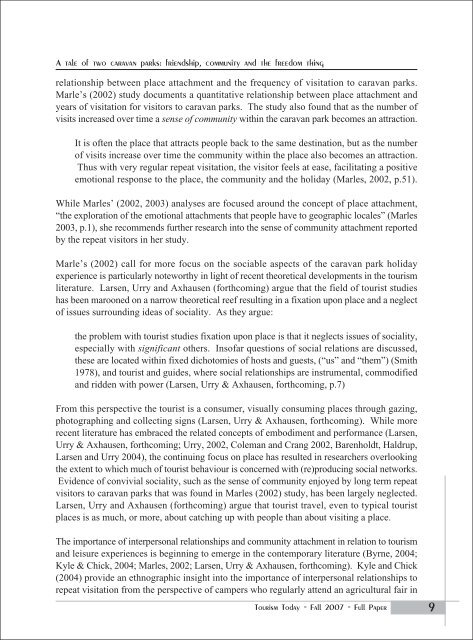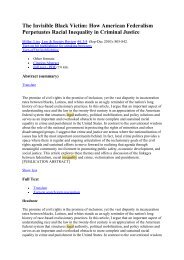Ski – resort and regional development: profile of visitors ... - E-Journal
Ski – resort and regional development: profile of visitors ... - E-Journal
Ski – resort and regional development: profile of visitors ... - E-Journal
Create successful ePaper yourself
Turn your PDF publications into a flip-book with our unique Google optimized e-Paper software.
A tale <strong>of</strong> two caravan parks: friendship, community <strong>and</strong> the freedom thing<br />
relationship between place attachment <strong>and</strong> the frequency <strong>of</strong> visitation to caravan parks.<br />
Marle’s (2002) study documents a quantitative relationship between place attachment <strong>and</strong><br />
years <strong>of</strong> visitation for <strong>visitors</strong> to caravan parks. The study also found that as the number <strong>of</strong><br />
visits increased over time a sense <strong>of</strong> community within the caravan park becomes an attraction.<br />
It is <strong>of</strong>ten the place that attracts people back to the same destination, but as the number<br />
<strong>of</strong> visits increase over time the community within the place also becomes an attraction.<br />
Thus with very regular repeat visitation, the visitor feels at ease, facilitating a positive<br />
emotional response to the place, the community <strong>and</strong> the holiday (Marles, 2002, p.51).<br />
While Marles’ (2002, 2003) analyses are focused around the concept <strong>of</strong> place attachment,<br />
“the exploration <strong>of</strong> the emotional attachments that people have to geographic locales” (Marles<br />
2003, p.1), she recommends further research into the sense <strong>of</strong> community attachment reported<br />
by the repeat <strong>visitors</strong> in her study.<br />
Marle’s (2002) call for more focus on the sociable aspects <strong>of</strong> the caravan park holiday<br />
experience is particularly noteworthy in light <strong>of</strong> recent theoretical <strong>development</strong>s in the tourism<br />
literature. Larsen, Urry <strong>and</strong> Axhausen (forthcoming) argue that the field <strong>of</strong> tourist studies<br />
has been marooned on a narrow theoretical reef resulting in a fixation upon place <strong>and</strong> a neglect<br />
<strong>of</strong> issues surrounding ideas <strong>of</strong> sociality. As they argue:<br />
the problem with tourist studies fixation upon place is that it neglects issues <strong>of</strong> sociality,<br />
especially with significant others. Ins<strong>of</strong>ar questions <strong>of</strong> social relations are discussed,<br />
these are located within fixed dichotomies <strong>of</strong> hosts <strong>and</strong> guests, (“us” <strong>and</strong> “them”) (Smith<br />
1978), <strong>and</strong> tourist <strong>and</strong> guides, where social relationships are instrumental, commodified<br />
<strong>and</strong> ridden with power (Larsen, Urry & Axhausen, forthcoming, p.7)<br />
From this perspective the tourist is a consumer, visually consuming places through gazing,<br />
photographing <strong>and</strong> collecting signs (Larsen, Urry & Axhausen, forthcoming). While more<br />
recent literature has embraced the related concepts <strong>of</strong> embodiment <strong>and</strong> performance (Larsen,<br />
Urry & Axhausen, forthcoming; Urry, 2002, Coleman <strong>and</strong> Crang 2002, Barenholdt, Haldrup,<br />
Larsen <strong>and</strong> Urry 2004), the continuing focus on place has resulted in researchers overlooking<br />
the extent to which much <strong>of</strong> tourist behaviour is concerned with (re)producing social networks.<br />
Evidence <strong>of</strong> convivial sociality, such as the sense <strong>of</strong> community enjoyed by long term repeat<br />
<strong>visitors</strong> to caravan parks that was found in Marles (2002) study, has been largely neglected.<br />
Larsen, Urry <strong>and</strong> Axhausen (forthcoming) argue that tourist travel, even to typical tourist<br />
places is as much, or more, about catching up with people than about visiting a place.<br />
The importance <strong>of</strong> interpersonal relationships <strong>and</strong> community attachment in relation to tourism<br />
<strong>and</strong> leisure experiences is beginning to emerge in the contemporary literature (Byrne, 2004;<br />
Kyle & Chick, 2004; Marles, 2002; Larsen, Urry & Axhausen, forthcoming). Kyle <strong>and</strong> Chick<br />
(2004) provide an ethnographic insight into the importance <strong>of</strong> interpersonal relationships to<br />
repeat visitation from the perspective <strong>of</strong> campers who regularly attend an agricultural fair in<br />
Tourism Today - Fall 2007 - Full Paper<br />
9














